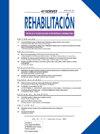威尔逊病的负担:对临床、心理和功能维度的洞察
IF 0.4
Q3 Medicine
引用次数: 0
摘要
威尔逊氏病(WD)是一种罕见的铜代谢遗传性疾病,具有多系统表现。尽管有可用的治疗方法,但患者往往会出现功能障碍。然而,临床表型、精神状态和残疾之间的关系仍未得到充分探讨。目的探讨成年WD患者疾病严重程度、认知能力、抑郁症状和功能障碍之间的关系。方法在这项前瞻性、单中心横断研究(2021-2023)中,采用WHODAS 2.0、GAS-WD、Mini-MoCA和PHQ-9对32例临床稳定的WD患者进行随访。使用WHODAS 2.0域评估功能结果。使用非参数检验分析临床变量与量表得分之间的关系。获得伦理批准(ref: 183-DEFI/165-CE)和知情同意。结果参与者平均年龄39.8±13.6岁;56.3%为女性。中位诊断延迟为1年。多数为肝型(56.3%)或神经型(37.5%)。WHODAS 2.0参与域受损最严重(中位数= 4.0,IQR 2-9)。WHODAS评分与GAS-WD评分(rs = 0.77, p < 0.001)和PHQ-9评分(rs = 0.65, p < 0.001)呈正相关,与Mini-MoCA评分呈负相关。在诊断延迟和残疾之间没有发现显著的关联。分层分析显示,不同性别(p = 0.83)或临床亚型(p = 0.47)的参与无统计学意义差异。结论WD患者的功能障碍与疾病严重程度、认知缺陷和抑郁症状显著相关,但与性别或临床亚型无关。WHODAS 2.0是一种可行的WD功能综合评价工具。解决心理和认知健康问题的多学科方法至关重要。本文章由计算机程序翻译,如有差异,请以英文原文为准。
The burden of Wilson's disease: Insights into clinical, psychological, and functional dimensions
Introduction
Wilson's disease (WD) is a rare genetic disorder of copper metabolism with multi-systemic manifestations. Despite available treatment, patients often experience functional impairment. However, the relationship between clinical phenotype, mental status, and disability remains underexplored.
Objective
To investigate the associations between disease severity, cognitive performance, depressive symptoms, and functional disability in adults with WD using validated instruments.
Methods
In this prospective, single-center cross-sectional study (2021–2023), 32 clinically stable WD patients followed at a tertiary neurology clinic were assessed with the WHODAS 2.0, GAS-WD, Mini-MoCA, and PHQ-9. Functional outcomes were evaluated using WHODAS 2.0 domains. Associations between clinical variables and scale scores were analyzed using non-parametric tests. Ethical approval (ref: 183-DEFI/165-CE) and informed consent were obtained.
Results
Participants had a mean age of 39.8 ± 13.6 years; 56.3% were female. Median diagnostic delay was 1 year. Most had hepatic (56.3%) or neurological phenotype (37.5%). The WHODAS 2.0 participation domain was the most impaired (median = 4.0, IQR 2–9). WHODAS scores correlated positively with GAS-WD scores (rs = 0.77, p < 0.001) and PHQ-9 (rs = 0.65, p < 0.001), and negatively with Mini-MoCA. No significant associations were found between diagnostic delay and disability. Stratified analysis revealed no statistically significant differences in participation across genders (p = 0.83) or clinical subtypes (p = 0.47).
Conclusion
Functional disability in WD is significantly associated with disease severity, cognitive deficits, and depressive symptoms, but not with gender or clinical subtype. WHODAS 2.0 is a feasible tool for comprehensive functional assessment in WD. Multidisciplinary approaches addressing mental and cognitive health are essential.
求助全文
通过发布文献求助,成功后即可免费获取论文全文。
去求助
来源期刊

Rehabilitacion
Medicine-Rehabilitation
CiteScore
0.80
自引率
0.00%
发文量
63
期刊介绍:
La revista que es desde hace más de 40 años la publicación oficial de la Sociedad Española de Rehabilitación y referente de la mayoría de las Sociedades de la Especialidad de los países americanos de habla hispana. Se publican 5 números pluritemáticos al año y uno monográfico sobre un tema del mayor interés y actualidad designado por el consejo de redacción.
 求助内容:
求助内容: 应助结果提醒方式:
应助结果提醒方式:


